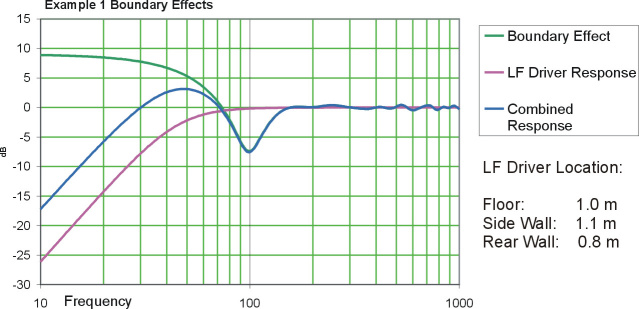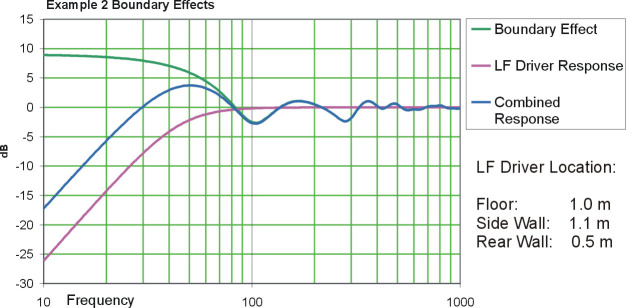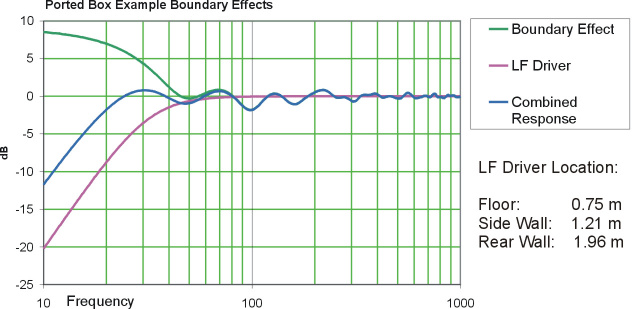I know that room modes (peaks and nulls) are a function of the geometry of a room, but is general room gain; that which allows a subwoofer that tapers off in the lower frequencies anechoically but to be flat "in room" something you can calculate at least roughly. I was told in my sub modeling threads that you shouldnt strive for a sub that models completely flat because it wont be flat in-room. Of course, I'd rather EQ away bottom end than try to add it, so to what end should I be considering room gain when modeling subs?
Guestimating room gain
Collapse
This topic is closed.
X
X
-
Room gain is determined by boundary loading, which is a function of the distance from the radiator to that boundary and the wavelengths involved.
The variability of room gain can be used to advantage when designing and placing a full range speaker - for example, see this plot, calculated with MathCAD, of the boundary loading effects and net effect on frequency response of a two way 8" speaker. The considerations are the same for a sub, but over a narrower frequency range. The calculation in this case uses the three closes boundaries - floor, rear wall, and side wall.
The first graphic shows an example of very poor choice in placement - all dimensions nearly the same.

The wave interactions of course cause a net lift in the LF response compared with the free field response, but there are also nulling effects in the transistion region, and if the dimensions are close, they will "pile up" on each other. Note the 7 dB suck out which occurs at 100 Hz, which would make integration of a sub or satelite system difficult. Net LF boost is 9 dB as would be expected going from a full space radiation mode to quarter space. Looking at the net response, it's not hard to imagine that a listener might characterize the sound as being rather "one note" in the bass- though it's not the speaker's fault at all.
The next figure shows a slightly better placement - but still far from ideal.

There are more ripples, not as high in magnitude, but still in the 2-1/2 to 3 dB range. Still, the 100 Hz region is strongly depressed, and there's a 4 dB lift in 50 Hz region. Still kind of one note, though not as much.
Let's look at this last example, using golden mean ratios and boundary distances designed to move the boundary lift to complement the speaker roll off.

Which would you want to listen to?
The most common situation for a sub is that it is on the floor, so that boundary distance is short- typically less than half a meter. This automatically means a half space instead of full space load. The other distances will influence the response and loading also- obviously, if you have everything back in the corner, all the boundary distances will be almost the same, and short, and one will get a pretty uniform non frequency dependent lift. That's one reason that placement is popular.
It is hard to avoid starting to see some issues due to boundary effect variations above 80 Hz, and for this reason, I often prefer 75 Hz or lower crossovers. Another alterntive is to use manifold loading into a boundary such as floor or ceiling. This may still require some care in the above 80 Hz area.DFAL
Dark Force Acoustic Labs
A wholly owned subsidiary of Palpatine Heavy Industries- Bottom
-
CJ, have you looked at CARA (Computer Aided Room Acoustics)? It's a program that allows you to comprehensively build a room and then analyze it for sonic performance. Not only do you put in the proper shape of the room, you can specify materials (sheetrock walls, carpeted floors, acoustic treatments, etc), furniture, speakers and other variables. It's a bit effort-heavy to initially put in your room and componentry, but then you can move the speakers/furniture around and reanalyze the results. It's worked very well for me..
David - Trigger-happy HTGuide Admin- Bottom
Comment
-
I'll second Cara, very cool program. In the 3 rooms I've modeled only one of them turned out to be "ideal" locations for a HT type system, and considering the room (T-shaped, about 30'x30' at it's widest/longest with 20ft ceilings through half of it) I was amazed that my sealed low-Q Tempest sub could do in there, by far the strongest response I've gotten out of that sub so far, to the point where I had to EQ DOWN the curve at 20Hz.
I should try it again and see how close it get's in my new room. One of the better tweaks I've purchased, but then again I'm a computer geek.- Bottom
Comment

Comment